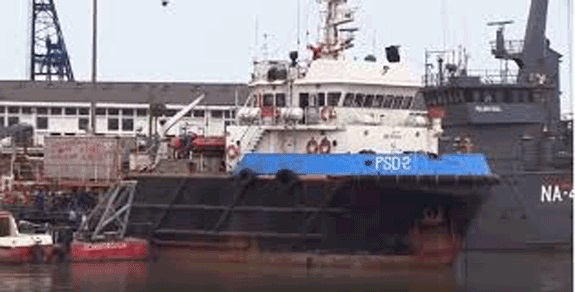Mozambique: Authorities confirm five deaths in Beira sinking - Watch
Crew flee Beira with tugboat and INAHINA beacons

Notícias
Three crew members of Bengali, Iranian and Syrian nationality absconded from near the Manarte Pier in the fishing port of Beira early on Tuesday morning aboard a PSD-2 tugboat registration number 5IM-675, taking with them beacons belonging to the National Institute of Hydrography and Navigation (INAHINA) of Mozambique.
They left owing 600,000 meticais (US$9,864.46) in anchorage fees from April this year to the Sofala Maritime Administration.
The disappearance of the vessel was noticed around 6:00 am on Tuesday. Local authorities activated police units but they had not located the vessel or its crew by the end of the day.
Sofala Maritime administrator António Reginaldo Vilanculos said he believed the tug would be returned to Manarte Pier by the intervention of Mozambican state agents.
The vessel, under the command of a Syrian captain, Asmael Alsarwt, with Iranian bosun Seyed Nasr Soltan Nasr a Bengali sailor Mohammad Jahangir Alam on board, was last spotted at mile 12, 30 kilometres from Beira Port.
According to Vilanculos, the departure of the boat was no ordinary matter, since at least ten agents of the Maritime, Lacustrine and Fluvial Police were on watch at the time.
“They are considered fugitives, because they left port without permission from the maritime authorities or police, much less the fishing port, where they were docking.”
He said that the vessel owed 600 ,000 meticais for its stay in Mozambican waters.
Also Read: Tug crew in Beira threatens to commit suicide – WATCH
Foreign tug crew still stuck in Beira
The ISS Mozambique agent responsible for the vessel, Manuel Paulo, contacted the owner, Hamid Perhayati, who is thought to be in Iran, at around 10:00 am yesterday, as soon as he learned of its unauthorised departure.
Perhayati activated the company’s VCR control system and found that the ship was on its way to the Port of Durban, South Africa. He then contacted a PSD-2 representative in South Africa, who revealed that the vessel had changed course and was heading for Tanzania.
Further enquiries revealed that Perhayati emailed Vilanculos yesterday asking him to get in touch with the Tanzanians with a view to retrieving the PSD-2 and detaining the three crew members.
In response to this request, Vilanculos submitted the matter to the Attorney General’s Office and the PRM.
Diário de Moçambique reports that the provincial commander of the PRM in Sofala, Alfredo Mussa, met with the Maritime Administrator and the captain of the Lake and River Police yesterday afternoon to clarify the situation. Police are expected to convene a press conference on the case today.
The ISS Mozambique agent, Manuel, told the Diário de Moçambique that the three crew members were still on Mozambican territory, claiming that some of their claims had not been met by the owner of the vessel.
“The crew demanded that the boss pay the entire crew US$50,000. But the owner of the vessel would only pay US$10,524 for the time that the boat was in the service of INAHINA. The one-year payment claim could be settled in Iran, he said, because that was where the contract was drawn up.”
Regarding the INAHINA material, Paulo said he did not understand why the company had not taken its beacons off the vessel, since it had authorisation. “It’s amazing to me that INAHINA material was still on the boat. The company was already authorised to remove the material shortly after negotiating with the owner of the ship,” he said.
He said that, even after the owner of the vessel had paid the US$10,000.00, he continued to honour commitments to provide the crew with food, water and medicine.
The Attorney General’s Office has already been informed of the illegal removal of the tug, so that it could open a criminal case and hold the guilty parties liable under international maritime law and other legislation in force, he said.
“This is the outcome, or a part of it, of a turbulent relationship between the crew and the owner of the vessel, which required the intervention of the provincial authorities of Sofala, with many contours still not properly understood,” Paulo concluded.













Leave a Reply
Be the First to Comment!
You must be logged in to post a comment.
You must be logged in to post a comment.